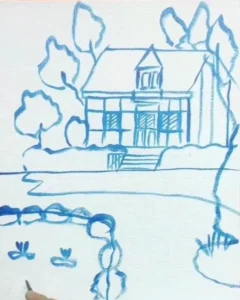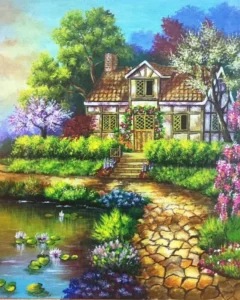Hey there! Let’s dig deeper into why forgetting about composition is a major mistake for acrylic painting beginners and how you can avoid it. Composition might sound like an intimidating art school term, but it’s really just about arranging the elements in your painting in a way that’s visually appealing and effective. Here’s why it matters and how you can master it.
Composition: The Unsung Hero of Great Paintings
When you start a painting, it’s easy to get caught up in the excitement of colors and brushstrokes. But without a good composition, even the most vibrant colors and skilled techniques can fall flat.
Composition is the backbone of your painting. It’s what makes your artwork feel balanced, cohesive, and engaging.
Here’s Why Composition Matters
Imagine you’re watching a movie, and the scenes are all over the place—no clear plot, random characters popping in and out, and the camera angles are chaotic. You’d probably lose interest pretty quickly, right? The same goes for paintings. Without a well-thought-out composition, your viewers won’t know where to look, and your painting can feel confusing or incomplete.
A strong composition guides the viewer’s eye, creates a sense of harmony, and enhances the overall impact of your artwork.
Common Composition Mistakes
1. Centring Everything
One common beginner mistake is to plop the main subject smack dab in the centre of the canvas. While this can work in some cases, it often leads to a static and uninteresting composition. Instead, try using the rule of thirds.
Rule of Thirds:
Imagine your canvas divided into a 3×3 grid (like a tic-tac-toe board). Place your main elements along these lines or at their intersections. This creates a more dynamic and balanced composition.

2. Ignoring Negative Space
Negative space is the empty space around and between the subjects of your painting. It’s just as important as the positive space (the space your subject occupies).
Balancing Act:
Pay attention to how you balance positive and negative space. Too much clutter can overwhelm the viewer, while too much empty space can make your painting feel sparse. Striking the right balance helps create harmony and focus.
3. Lack of Focal Point
Without a clear focal point, your painting can feel scattered and aimless. The focal point is the main area of interest that draws the viewer’s eye.
Creating a Focal Point:
Use contrast, detail, and color to highlight your focal point. This could be the brightest spot, the area with the most detail, or where the most interesting colors are. Make sure this area stands out from the rest of your painting.

Tips for Better Composition
1. Plan Before You Paint
Take a few minutes to sketch out your composition before you start painting. This doesn’t have to be a detailed drawing—just a rough outline to help you visualize the placement of your main elements.
Thumbnail Sketches:
Create small, quick sketches (thumbnails) to experiment with different compositions. This allows you to try out various arrangements without committing to a full painting.


2. Use Leading Lines
Leading lines guide the viewer’s eye through the painting, directing them towards the focal point.
Examples of Leading Lines:
These can be actual lines like roads, rivers, or tree branches, or implied lines like the direction a person is looking or the way light falls. Use them to create a sense of movement and flow.
3. Play with Perspective
Perspective can add depth and interest to your composition.
Foreground, Middle Ground, Background:
Think about how elements in the foreground, middle ground, and background interact. Overlapping objects, changes in size and detail, and atmospheric perspective (things get lighter and less detailed as they recede) can all help create a sense of depth.

4. Balance and Symmetry
While perfect symmetry can sometimes be dull, a sense of balance is crucial.
Asymmetrical Balance:
You don’t need everything to be perfectly symmetrical, but balance the visual weight of your elements. A large shape on one side can be balanced by several smaller shapes on the other, or by using contrasting colors
5. Use Color Wisely
Colors can greatly influence your composition.
Color Contrast:
Use contrasting colors to draw attention to the focal point. Warm colors (reds, oranges, yellows) tend to come forward, while cool colors (blues, greens) recede. Use this to your advantage to create depth and focus.

Practice Makes Perfect
Composition is something that improves with practice. The more you paint, the better you’ll get at intuitively arranging your elements. Don’t be afraid to experiment and make mistakes—that’s how you learn!
In Conclusion
Forgetting about composition is a mistake that can turn even the most technically skilled painting into a visual mess. But by planning ahead, balancing your elements, and guiding your viewer’s eye, you can create paintings that are not only beautiful but also compelling and engaging. So next time you sit down to paint, take a moment to think about your composition. It’s the secret ingredient that can elevate your artwork to the next level. Happy painting!

Pingback: Common Mistakes to Avoid as an Acrylic Painting Beginner – Yvie Marie Art